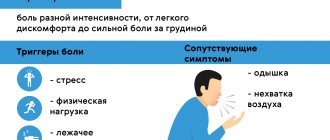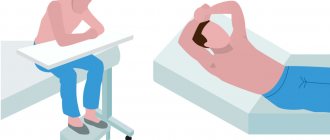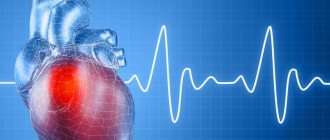Causes of pain
When the stomach is filled with food, highly sensitive receptors from the lower parts of the esophagus irritate and overstimulate the vagus.
Against this background, ischemia occurs - a symptom of “robbing” blood circulation in the heart muscle (gastrocardiac syndrome). Gastrocardial syndrome is characterized by the following features:
- pain in the heart after eating;
- the pain resembles angina attacks (aches, squeezes);
- increased heart rate, tachycardia;
- the pain is local, without irradiation;
- increased blood pressure, weakness;
- relief of symptoms occurs after vomiting, which patients induce independently.
There are a number of other diseases that cause pain in the heart area associated with eating. These include problems with the gastrointestinal tract:
- Gastroesophageal reflux disease (GERD) is a pathology in which part of the gastric contents enters the esophagus. There is a feeling of heartburn, chest pain, bloating and belching.
- Gastritis is an inflammation of the gastric mucosa caused by an autoimmune process or aggressive environmental influences. Pain appears during the period of exacerbation of the disease; after appropriate treatment and diet, symptoms disappear.
- Peptic ulcer is a violation of the integrity of the gastric mucosa. Pain appears when the affected areas are irritated by food or the aggressive action of hydrochloric acid.
- Dumping syndrome occurs after gastric resection. Symptoms: cardialgia, changes in blood pressure, dizziness, sweating, loss of consciousness. The reason for the complaints is the rapid flow of unprocessed food from the stomach into the small intestine, which causes the wall of the hollow organ to stretch and release histamine and kinins, which increase peristalsis and cause vegetative crises.
Lapina T.L. Esophageal pain // Medical Bulletin. – 2006. – No. 32 (375). - October 11. - With. 16.
Esophageal pain
T.L.
Lapina A detailed and complete description of such an important symptom as pain allows the doctor to “find” the correct diagnosis, assess the stage of the disease and possible complications.
Pain in diseases of the esophagus
is often very “eloquent”, clearly indicating the nosological form, but there are also frequent situations when chest pain requires a broad differential diagnosis, and it is not easy to identify its connection with esophageal pathology.
T.L. Lapina, associate professor of the course “Functional diagnostics and pharmacotherapy in gastroenterology” at the Department of Family Medicine of the MMA named after. THEM. Sechenov
It is necessary to determine whether the pain is caused by swallowing or not. Pain when swallowing
is called
odynophagy
.
If there is no connection between pain and swallowing, it is called spontaneous. As a feature of odynophagia, its possible combination with dysphagia should be noted. Dysphagia
, which is defined as difficulty, obstruction or discomfort during swallowing (that is, when food passes through the oral cavity, pharynx and esophagus) when pathological changes in the esophagus become more severe, can indeed develop into odynophagia or become an additional symptom when painful swallowing occurs.
Odynophagia
, unlike spontaneous pain, as a rule, very clearly indicates that
the pain belongs to the esophagus
. Diseases of the esophagus with odynophagia are often accompanied by destructive changes in the mucous membrane: chemical burn of the esophagus, infectious esophagitis (especially viral - herpetic, cytomegalovirus, but also bacterial and fungal), drug esophagitis, erosive and erosive-ulcerative esophagitis with gastroesophageal reflux disease, esophageal tumors. The severity of odynophagia can vary, be minor and occur only when swallowing solid food or hot drinks, or it can accompany every meal and be extremely painful. Odynophagia can make the patient refuse to eat. We observed a young woman who came to the clinic with complaints of intense pain behind the sternum when passing solid and liquid food (the most severe pain was localized in the middle third of the sternum); a feeling of difficulty in passing food in the middle third of the sternum and constant pain along the esophagus, especially in the middle third of the sternum, which was so pronounced that in order to alleviate it, the patient took a forced position (lying on her stomach or tilting her body forward in a vertical position) . Thus, in one case there was a combination of odynophagia, dysphagia and esophageal pain; not related to swallowing. The complaints were due to a large ulcer localized on the posterior wall in the middle third of the esophagus, the formation of which was caused by taking a nutritional supplement. If the pain is not caused by swallowing (or is not associated with other typical esophageal symptoms, such as heartburn), then it can be difficult to determine its cause, since pain localized to the chest is very common. Even in the most general terms, it is necessary to differentiate a number of possible sources/causes of pain (see table).
Table. Causes of chest pain
Cardiac
| Non-cardiac | |
| - ischemic - non-ischemic |
|
Determine the true cause of chest pain
It's not always easy.
Thus, according to SR Achem (2005), in the USA in the late 80s. last century, when conducting coronary angiography, up to 30% of those examined did not have damage to the coronary arteries of the heart: with a general count throughout the country, up to 300 thousand cases of non-cardiac pain in the chest could be detected annually. When analyzing domestic data from coronary angiography of 425 patients, changes in the coronary vessels were not detected in 9.4% of cases, and the diagnosis of gastroesophageal reflux disease was established in 6.4%. The following should be listed as causes of esophageal pain: acid-peptic factor during reflux; smooth muscle spasm; stretching of the esophagus; damage to the sensory nerve endings of the esophagus during tumor growth. Accordingly, gastroesophageal reflux disease is most often accompanied by esophageal pain. It is recognized that in 50% of patients with noncardiac chest pain, the cause of pain is precisely gastroesophageal reflux. More rare causes of pain are diseases caused by movement disorders (esophagospasm, achalasia cardia) and tumors. With esophagospasm, the pain is intense, localized in the sternum or high in the epigastric region, radiating along the front surface of the chest up to the neck, into the lower jaw, shoulders, occurring either spontaneously or when swallowing food or saliva, or during neuropsychic stress. With achalasia cardia, the pain is localized at the level of the lower third of the sternum and usually occurs after eating due to overstretching of the esophagus with stagnant contents. With gastroesophageal reflux disease, pain is also localized behind the sternum, can be pressing, burning, radiates to the back, often occurs in the supine position and after eating, decreases or disappears after taking antacid or antisecretory drugs. To establish the esophageal cause of chest pain, it is necessary to carefully question the patient. The combination of pain with other esophageal symptoms (heartburn, dysphagia) significantly helps in the interpretation of the pain syndrome. With a typical clinical picture of gastroesophageal reflux disease, proton pump inhibitors can be immediately prescribed, treatment of which is likely to lead to the disappearance of pain. In the absence of a clue in the form of typical esophageal symptoms, a detailed instrumental examination may be required. An X-ray examination of the chest (to exclude lung diseases) and an ultrasound examination of the abdominal organs (to exclude pancreatobiliary pathology) are advisable. X-ray examination of the esophagus and stomach will make it possible to establish a diagnosis of esophagospasm, achalasia cardia, tumor, but for most cases of reflux disease it will be uninformative. The importance of endoscopy also cannot be overestimated, since pain can be a manifestation of non-erosive (endoscopically negative) reflux disease. 24-hour pH monitoring
has been repeatedly studied as a method for objectively identifying the cause of non-cardiac chest pain.
Its diagnostic value is debated. About 40% of patients with noncardiac pain demonstrate pathological acid reflux, a positive symptom index. However, recorded acid reflux may in some cases not indicate the presence of reflux disease, including as a cause of non-cardiac pain. Esophageal manometry
, unfortunately, cannot be considered as an optimal diagnostic test. According to WG Paterson (1998), pathological manometry data are found in 60% of patients with non-cardiac chest pain, but the identified changes are insignificant, atypical (that is, not characteristic of esophagospasm), regarded as nonspecific motor disorders and are unlikely to have significant clinical significance . In addition, episodes of non-cardiac pain may be irregular, which also makes their diagnosis difficult. Carrying out manometry with provocative tests (acid perfusion, betanicol stimulation or balloon distension of the esophagus) in most cases allows to initiate pain syndrome and increases the accuracy of diagnosis, however, it becomes difficult and uncomfortable for the patient. It becomes obvious that a simple and informative test with a proton pump inhibitor (for example, omeprazole) serves as a very attractive diagnostic method for gastroesophageal reflux disease with extraesophageal manifestation - non-cardiac chest pain. If after a trial course of a proton pump inhibitor the pain goes away, then it was caused by reflux. Thus, F. Cremonini et al. (2005), in a meta-analysis of studies undertaken to compare the proton pump inhibitor test with endoscopy and pH monitoring, found that the sensitivity of the test was 80% and the specificity 74% for diagnosing this condition. The same authors conducted a meta-analysis of eight randomized controlled trials to evaluate the effectiveness of a proton pump inhibitor treatment for noncardiac chest pain compared with placebo. The risk of continued episodes of non-cardiac chest pain after treatment with a proton pump inhibitor was 0.54 (95% CI (confidence intervals) 0.41-0.71), NNT (number needed to treat) - 3 (95% CI 2-4 ). It was concluded that proton pump inhibitors may be used to treat non-cardiac chest pain. A recent review of the literature on this topic (JR Malagelada, 2004) recommends the possibility of prescribing a proton pump blocker for non-coronary chest pain at a standard dose for a short course of treatment, for example one week, which may be sufficient to relieve pain. Other drug approaches to the treatment of esophageal pain include nitrates and calcium channel blockers (for hypermotor dyskinesias of the esophagus), as well as antidepressants.
What examinations are necessary to undergo for an accurate diagnosis?
If you feel discomfort in the heart area during or after eating, seek help from a doctor - a cardiologist or gastroenterologist. Mandatory priority examinations: general and biochemical blood tests, ECG, echocardiography to detect abnormalities in the structure of the heart. In addition, the gastrointestinal tract is also diagnosed: they do an ultrasound of the abdominal organs, fibrogastroduodenoscopy to identify pathologies of the stomach lining, and contrast radiography to exclude a hiatal hernia. For the purpose of differential diagnosis, medications are prescribed (proton pump inhibitors, which reduce the secretion of hydrochloric acid).
All research methods are prescribed only by a doctor after carefully collecting a medical history, examination, palpation and auscultation data. If gastrocardial syndrome is suspected, endoscopic examinations are contraindicated, since vagal stimulation and sudden cardiac arrest are possible.
Action tactics
If the patient experiences pain in the heart area while eating, it is advisable to stop eating and take a comfortable body position.
When a patient has such an attack for the first time and it is accompanied by pressure or burning in the chest, tachycardia, shortness of breath, they seek medical help.
Some patients know that vomiting alleviates the condition, so they induce it artificially.
To prevent recurrent attacks, regardless of the cause of pain, stick to a diet, eat small portions, but more often. Food should be thermally processed and neutral; it is important to chew food thoroughly. Depending on the diagnosis, the doctor prescribes medications: antispasmodics, proton pump blockers, antibiotics if Helicobacter pylori infection is detected. For organic lesions of the esophagus, surgical treatment is recommended.
Why else can you feel chest pain?
Chest pain can be related to the respiratory, digestive and muscle organs.
Respiratory problems
- Pneumonia. Pneumonia is a complication after suffering from influenza or other colds. The patient experiences shortness of breath and severe pain when trying to take a breath.
- Lung collapse. Pneumothorax, or collapsed lung, occurs when air gets trapped between the lungs and the ribs. The patient experiences shortness of breath and severe pain.
- Pleurisy. A disease characterized by inflammation of the pleura. Pain in the chest of a patient with pleurisy occurs during every attempt to take a breath.
- Lungs' cancer. Pain can occur even at rest. This is often accompanied by a wet cough with blood in the sputum.
Digestive problems
Pathologies of the gastrointestinal tract also cause chest pain:
- Heartburn. This condition occurs when gastric juice enters the esophagus. Often with heartburn, a burning sensation appears behind the sternum.
- Diseases of the pancreas and gall bladder. Gallstones or inflammation of the gallbladder can cause pain in the right side of the chest.
- Dysphagia. Pathology characterized by problems with swallowing. In some cases, it can cause severe chest pain.
Muscle and bone problems
Muscle and bone problems causing chest pain:
- Rib injuries. Pain occurs with fractures or bruises of the ribs and soft tissues.
- Fibromyalgia. The disease is characterized by dull pain in the muscles, the nature of which is still unknown. The pain caused by fibromyalgia can last for several months.
- Costochondritis. A disease in which the cartilage connecting the chest and ribs becomes inflamed. Signs of costochondritis resemble a heart attack.
conclusions
Do not neglect the importance of the symptom when your heart hurts after eating. This can be a signal of serious illness or interfere with normal life activities. If discomfort occurs in the chest while eating, consult a doctor who will prescribe the necessary examinations and offer the correct solution to the problem with the help of medication or surgical treatment. Diet and psychotherapy have a significant effect. If you are worried about tachycardia after eating, we recommend that you read our expert’s article on this topic.







